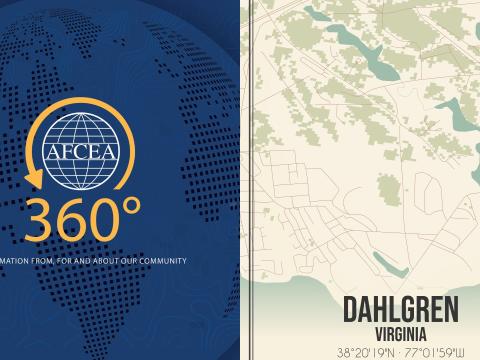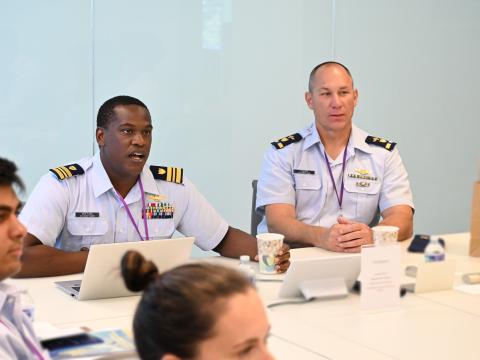Sea Services Address Resourcing Gloom and Doom
The U.S. Navy, Marines and Coast Guard face funding challenges—including continuing resolutions, the potential for sequestration and inflation effects—that negatively impact purchasing power and affect readiness and modernization efforts.
That was the message from a panel of resource officers from the three services on the final day of the February 13-15 WEST conference in San Diego. The panel included Rear Adm. Matt Lake, assistant commandant for resources and chief financial officer, U.S. Coast Guard; Vice Adm. John Skillman, deputy chief of Naval Operations for integration of capabilities and resources, N8, Office of the Chief of Naval Operations; and Lt. Gen. James Adams III, Marine Corps deputy commandant for programs and resources; and panel moderator, Adm. Jonathan Greenert, USN (Ret.) former chief of naval operations.
All panelists agreed their services do not have the resources to fulfill the National Security Strategy. They also agreed that continuing resolutions (CRs), short-term funding to keep the government running in lieu of Congress passing annual budgets, constrain their ability to fund the things they need. And a full-year continuing resolution rather than the now-routine six-month CRs would be particularly devastating.
“The Navy is currently resource challenged in meeting the National Defense Strategy and National Security Strategy with the current continuing resolution in [fiscal year] 2024, the threat of sequestration from the Fiscal Responsibility Act and the loss of buying power due to rising costs from prior high inflation,” Adm. Skillman asserted.
He provided several statistics to back up his assertion. “A full-year CR would reduce the Navy’s topline by about $11 billion this year. When combined with the restrictions on how we can spend our money under a CR, that impact doubles to about $22 billion to $23 billion.”
That would mean a reduction of 5% to 10% from the Navy’s budget request of $202 billion. “And we’re already halfway through this fiscal year,” Adm. Skillman added. “We are mitigating the impacts as best we can right now, but a full-year CR would be unprecedented and cause serious damage to our ability to execute the defense and security strategy.”
Adm. Skillman said he is “laser focused on ensuring we stay resourced for the current and future fight” and added that while the service faces funding and recruiting challenges, it is “strong, ready and present today.”
Lt. Gen. Adams described the fiscal situation as dire. “Frankly, the fiscal situation that we’re in right now is extremely complicated and extremely dire.”
He noted the effects of both continuing resolutions and inflation impose a degree of uncertainty. “It’s really all about uncertainty, and it’s about lost buying power—uncertainty because we have just gone through, over the past four years, a time of inflation that we have never seen since like the 1980s.
Gen. Adams pointed out that inflation peaked in 2022 at about 9.1% and is now at about 3.1% as of January, but those higher rates continue to ripple across the Marine Corps. “The effects of that 9.1% inflation in 2022, when our purchasing power and our outlays were identified two years prior when that inflation didn’t exist, it just compounds. We continue to have uncertainty with the inflation and how it affects our buying power,” he explained.
While some people may say that the 2023 fiscal year budget was the Defense Department’s highest ever, Gen. Adams asserted, it was also the budget most impacted by inflationary factors. “So, the buying power of the dollar in 2023 didn’t match the next highest one.”
While there is no single silver bullet to solve such a complex challenge, he added, “I will tell you sufficient, stable and predictable resourcing will go a long way, and that’s totally within our control as a government.”
Gen. Adams warned that the panel would “talk a lot of doom and gloom here today” but that the Marine Corps is strong, motivated, in position and “none of us would have ever become a Marine if we thought it was going to be easy.”
The Coast Guard budget is roughly $13.7 billion per year, which is relatively small compared to the other maritime services, Adm. Lake noted, adding however that, “you can’t really buy your way out of the problem” and that “this is about making do with the resources you have to make the best decisions in terms of return on investment for the nation.”
He described the Coast Guard’s increased “demand signal” over the last decade or so, which includes interdicting transnational drug trafficking; coping with maritime migration due to destabilization in Haiti and Cuba; increased natural disasters, which required the Coast Guard to save 15,000 lives last year; and increased need for the service to operate in the Indo-Pacific region to build partnerships and help stabilize the region.
Frankly, the fiscal situation that we’re in right now is extremely complicated and extremely dire.
A large part of the Coast Guard’s budget prioritizes recapitalization of the fleet, which was largely built in the 1960s and 1970s. That process should be mostly complete in the next 10 to 15 years. Aging infrastructure is also an issue, as is recruiting, which is a challenge across the military.
The panelists also discussed unfunded requirements or capabilities for their respective services. The military services are required by law to provide Congress with a list each year of priorities that did not make it into the formal budget request.
For the Coast Guard, that includes aircraft, such as C-130s for maritime surveillance; surface vessel investments, such as fast response cutters for the Indo-Pacific; infrastructure like Coast Guard installations and the industrial infrastructure.
The Navy and Marines are still working through their fiscal year 2025 budget requests and the unfunded requirements lists, but Gen. Adams said that the Fiscal Responsibility Act spending caps for 2024 and 2025 will impact the unfunded priority list.
While he didn’t provide a detailed list, he said the unfunded priorities “orient around key force design initiatives” for modernization, but the service will likely try to increase the capacity for systems that are just now being fielded. The list also could include force design and talent management efforts, and quality of life initiatives, such as improved barracks, child care centers and other facilities.
Gen. Adams indicated that none of those items will be in the budget request because of the spending caps. “Those caps really were detrimental—it forced some really, really hard choices,” he said.



Comments